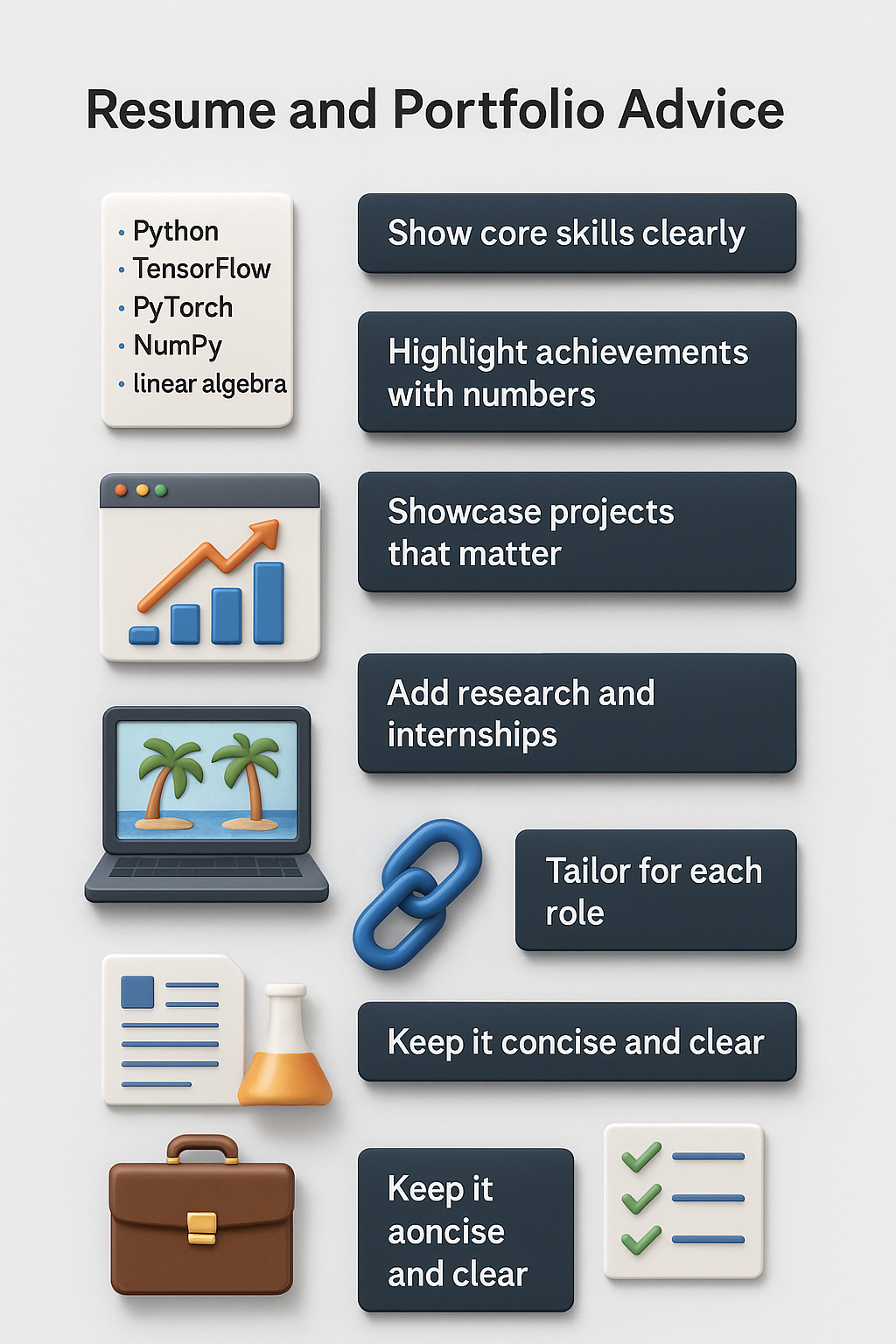Artificial intelligence is no longer a distant concept. It is shaping daily life and creating new professions. Deep learning, a specific part of machine learning, is now the core of medical imaging, finance risk analysis, and voice technology. For many, this field looks attractive not only for its salaries but also for its influence on health, business, and innovation.
The aim of this guide is to explain the skills you need, the resources that matter, and the paths that can help you enter this career. The information is written in clear English, supported by trusted sources, and designed for people who want a realistic picture of how deep learning jobs are built.

What Deep Learning Really Means
Deep learning uses multi layer neural networks that can learn from vast datasets. These systems can process millions of images or sentences and detect hidden patterns. They already support radiologists in detecting cancers with better accuracy as shown in Nature Medicine. They also assist banks in monitoring fraud at scale and allow personal assistants to recognize voice commands.
Unlike traditional algorithms that depend on handcrafted rules, deep learning allows machines to learn features on their own. This independence makes the field powerful but also resource heavy. Training a single advanced model can cost thousands of dollars in compute power. At the same time open source frameworks and cloud solutions have reduced barriers, making the field accessible for students and professionals.

Why This Career Has Become Attractive
There are clear reasons why thousands of professionals are moving into this area.
- The job market for deep learning is expanding each year. Employers in healthcare, finance, automotive and education are hiring specialists. According to reports published in 2023, the number of AI job postings grew by more than 20% compared to the previous year.
- Salaries are competitive. In the United States median salaries for machine learning engineers range from $120 000 to $160 000 per year. Specialized experts in deep learning often command even higher pay.
- The diversity of roles allows career flexibility. A researcher might work on theoretical models, while an engineer may focus on building solutions for speech recognition or medical image analysis.
For anyone who enjoys problem solving and wants to be part of applied science, this career path offers both intellectual satisfaction and financial security.
Essential Skills You Must Master
Employers seek candidates who combine theory and practice. The following skills form the foundation.
Mathematics
A strong understanding of calculus, linear algebra, and probability is essential. These areas allow you to grasp optimization and backpropagation. Linear algebra helps you handle matrices and tensors, while probability theory lets you interpret model outputs. MIT OpenCourseWare provides open access courses that are widely used by students preparing for this field.
Programming
Python dominates the deep learning ecosystem because of its readability and vast library support. Frameworks such as TensorFlow and PyTorch are critical. Employers expect candidates to preprocess data, implement models, and debug training runs.
Algorithmic Understanding
Knowledge of neural network architectures such as convolutional networks and recurrent networks is a must. You also need to know optimization methods like stochastic gradient descent. Applying techniques such as dropout or batch normalization helps reduce overfitting and improve real world performance.
Practical Tools
If you want to build and test models directly, you can use the Graphlogic Generative AI & Conversational Platform. It provides infrastructure that supports generative and conversational AI without requiring your own data center. This kind of tool is increasingly common in industry.

Building Experience That Employers Value
Certificates are useful but experience is the real currency. Recruiters prefer candidates who show practical results.
Projects provide the best evidence of skill. Examples include building an image recognition system that classifies thousands of objects, training a sentiment analysis model that processes social media text, or designing a speech recognition pipeline. These projects can be shared on GitHub and linked in a portfolio.
Competitions are another strong path. Kaggle hosts global challenges that let you test your abilities on diverse datasets. A high ranking profile on Kaggle adds real weight to your resume.
Internships and research assistantships help too. Many universities and AI companies hire interns to support ongoing projects. These roles often lead to permanent positions.
If you are interested in working with speech applications, the Graphlogic Text-to-Speech API can serve as a test environment to build prototypes. Showing that you can integrate commercial APIs with your own models demonstrates applied skill.
The Best Resources to Learn Deep Learning
The right learning material can speed up your progress.
Online Courses
- Stanford’s Machine Learning course by Andrew Ng is widely considered a strong introduction.
- Udacity’s Intro to Machine Learning is practical and project focused.
- CS231n by Andrej Karpathy is a deep dive into convolutional networks.
Books
- Deep Learning by Ian Goodfellow, Yoshua Bengio, and Aaron Courville is the standard reference text.
- Grokking Deep Learning by Andrew Trask provides a beginner friendly path.
Tutorials
Interactive tutorials are available on TensorFlow Tutorials. These guides allow you to build code step by step.
Combining courses, books, and tutorials creates a balance of theory and practice.
Trends and Forecasts in Deep Learning
The field is evolving at a fast pace. Several new directions are gaining attention.
- Explainable AI: Regulators and hospitals demand models that are transparent. This is especially important in clinical decision support where doctors must understand why a system recommends a diagnosis. The World Health Organization has emphasized the ethical need for transparency.
- Federated Learning: With rising privacy concerns, training models on distributed devices without centralizing data is becoming a requirement.
- Edge AI: Running models on devices like smartphones and IoT sensors reduces latency and improves security.
- Integration with healthcare: According to Science, deep learning models for pathology and genomics are already showing promising results.
- Scaling costs: Training frontier models can exceed $10 000 in compute costs. This pushes research into efficient architectures and hardware acceleration.
Looking ahead to the next five years, roles in AI infrastructure engineering, privacy preserving modeling, and explainable AI will expand rapidly. Continuous upskilling will be the only way to stay relevant.

Resume and Portfolio Advice
Your resume and portfolio are often the first impression you make. In deep learning, employers want to see evidence that you understand the fundamentals and can apply them to real problems. A strong application highlights both your technical knowledge and your ability to deliver measurable results.
Show Core Skills Clearly
List your technical foundations in a structured way. Recruiters and automated filters scan for keywords such as Python, TensorFlow, PyTorch, NumPy, and linear algebra. Placing these skills near the top of your resume ensures they are visible. Mention mathematical areas such as calculus, probability, and statistics because they remain central to how models work.
Highlight Achievements with Numbers
Do not just list responsibilities. Show outcomes with specific numbers. For example, write that you improved model accuracy by 15% on a benchmark dataset or reduced training time by 20% after optimizing data pipelines. Metrics give weight to your claims and demonstrate impact.
Showcase Projects That Matter
Employers value applied work over theoretical knowledge alone. Include projects such as an image classifier for medical data, a sentiment analysis model for customer reviews, or a speech recognition pipeline. Describe the datasets, methods, and final results. Make it clear how your work could be useful in practice.
Link to Public Work
Provide links to GitHub repositories so employers can review your code. Ensure your repositories are clean, with documentation and clear instructions for running the code. Pin the most relevant projects to the top of your profile. Consider adding a short personal website that summarizes your projects, publications, and contributions to open source libraries.
Add Research and Internship Experience
If you have worked in academic labs or company internships, detail the outcomes. Mention published papers, poster presentations, or prototypes you contributed to. For example, state that you supported a team developing a convolutional neural network that improved classification accuracy on a medical dataset by 10%. Use numbers whenever possible to give credibility.
Tailor for Each Role
Customize your resume for every job application. If a company works on natural language processing, place your NLP projects at the top. If they focus on healthcare imaging, highlight your image based projects. Employers notice when resumes are carefully tailored rather than generic.
Keep it Concise and Clear
Limit your resume to one or two pages. Use simple sentences and clear formatting. A cluttered resume makes it harder for recruiters to see your skills. Your portfolio and GitHub can provide the detail, while the resume serves as a focused snapshot.

Job Search Strategies
Finding a role in deep learning is not only about sending applications. It is about building visibility, showing credibility, and demonstrating that you can contribute to real projects. The process involves several stages, and each requires planning.
Where to Look
Popular job sites such as LinkedIn and Indeed often list hundreds of AI openings. However, many roles never appear there. Specialized career pages of AI companies or research labs frequently post opportunities first. Some positions are only listed on dedicated pages of large companies or on university labs that collaborate with industry. For example, speech recognition companies sometimes post openings for engineers who focus on audio models and do not advertise them widely.
It is important to set alerts on multiple platforms. LinkedIn allows you to filter by remote work, seniority, and required skills. Kaggle also has a job board that lists AI related roles. Professional associations like the Association for Computing Machinery maintain newsletters that include openings in machine learning.
How to Apply
Recruiters value applications that are tailored. Submitting the same resume to dozens of companies rarely works. Each application should highlight projects and skills relevant to that role. For instance, if a company focuses on healthcare imaging, you should mention any projects related to convolutional neural networks for image classification.
Even if you do not meet 100% of the listed requirements, applying shows initiative. Employers know that perfect candidates rarely exist. What matters is your ability to learn quickly and solve problems.
Networking as a Career Tool
Networking is one of the strongest factors in securing a role. Meeting people at conferences, hackathons, or academic events often creates opportunities that are not posted publicly. Online communities can also be valuable. GitHub, Reddit, and specialized machine learning forums allow you to share work and connect with experts.
Contributing to open source projects gives you visibility. Many employers notice candidates who actively improve widely used libraries. Presenting at local meetups or participating in virtual workshops is another way to build your name. A visible profile increases the chance of being contacted by recruiters directly.
Interview Preparation
Preparing for technical interviews is essential. Interviews often include coding exercises where you must solve a problem within a short period. These may involve writing a function to train a small neural network or debugging a simple dataset pipeline.
Companies also test conceptual understanding. You may be asked to explain how backpropagation works, why dropout layers help reduce overfitting, or how to compare two models using cross validation. Practice is important. Sites like LeetCode or HackerRank offer problems that simulate real interview tasks. Reviewing academic papers and staying current with model architectures can help answer deeper theoretical questions.
Using Recruiters and Referrals
Specialized recruiters who focus on AI roles can help you access positions not listed elsewhere. Building relationships with them gives you insight into what skills are in highest demand. At the same time, referrals from colleagues or professors often carry more weight than cold applications. Reaching out politely to professionals in your field on LinkedIn can sometimes lead to internal referrals.
Building Your Presence
Your digital footprint also plays a role in the job search. A GitHub portfolio with clean, well documented projects is essential. A LinkedIn profile that lists your projects and includes recommendations from peers makes you more attractive to employers. Writing short blog posts that explain your projects or your insights from reading research papers shows that you can communicate ideas clearly. Many companies value this skill as much as technical expertise.
Balancing Breadth and Focus
It is tempting to apply to every role with AI in the title. However, employers look for people who have focus. Choose a sector that interests you, such as healthcare, speech technologies, or autonomous systems. Tailor your applications around this focus while keeping your skill set broad enough to adapt.
FAQ
In the United States entry level roles often start near $110 000 per year. Experienced professionals can earn $160 000 or more. Some specialized experts reach above $200 000 depending on the sector and region.
No. Many professionals enter with bachelor or master degrees. Employers care more about your ability to build and apply models. A strong portfolio often outweighs academic titles.
With focused study it may take 12 to 18 months to gain solid foundations. This includes math review, coding practice, and building projects.
Healthcare, finance, automotive, and technology platforms hire actively. New demand also comes from education technology and defense research.
The field is dynamic but demand is strong. Jobs are tied to practical use cases that companies need, such as speech recognition, fraud prevention, or medical diagnostics. Stability depends on keeping your skills updated.




